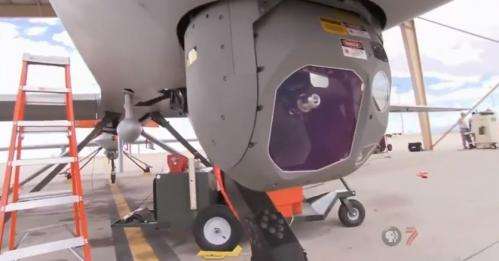January 29, 2013 report
PBS stares back at 1.8-gigapixel ARGUS drone imaging system

(Phys.org)—Described as the next generation of surveillance, and representing the world's highest resolution camera, the ARGUS-IS, which stands for Autonomous Real-Time Ground Ubiquitous Surveillance Imaging System, is featured on PBS' NOVA program on drones, which describes the latest technologies behind drones. The program carries a demonstration of the imaging system, which is the result of development work at BAE Systems, a defense, security and aerospace company.
The BAE team developed the ARGUS-IS array as a project funded by the Defense Advanced Research Projects Agency (DARPA). The importance of this surveillance imaging system centers on its unprecedented capability in finding, tracking and monitoring events in real time. The system was demonstrated by Dr. John Antoniades, technical group director for Intelligence, Surveillance and Reconnaissance Exploitation Technologies at BAE. The demo was part of the NOVA episode "Rise of the Drones." He did not show the real Argus sensor because it is classified. Antoniades said the government, however, gave permission to discuss its basic capabilities. He made reference to the system having the world's highest resolution camera, which can be attached to the belly of a UAV.
With its capabilities, the system can detail areas within a very broad context, with enough zoom power to see people waving their arms and walking around in parking lots. This is a 1.8-gigapixel video surveillance platform that can resolve details as small as six inches from an altitude of 17,500 feet.
He said its imaging power involves basic cellphone technology. The BAE team decided to string together 368 imaging sensors focused on the ground via image-stabilized telescopic lenses. In this manner, the ARGUS-IS array links together images to perform surveillance over enormous terrain in realtime.
In February 2010, after completing a flight test of the ARGUS-IS, Dr. Steven Wein, BAE director of optical sensor systems, spoke of its technical edge over previous work in imaging systems.
"Very high-resolution imaging systems required for vehicle and dismount tracking typically have a 'soda-straw' view that is too small for persistent coverage. Existing wide-area systems have either inadequate resolution or require multiple passes or revisits to get updates." He said that the ARGUS-IS system overcomes the fundamental limitations of current airborne surveillance systems.
In 2007, BAE Systems received an $18.5 million contract from DARPA to develop a new class of intelligence, surveillance, and reconnaissance systems and capabilities.
More information: www.pbs.org/wgbh/nova/military … e-of-the-drones.html
© 2013 Phys.org




















